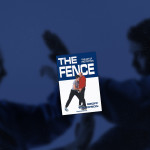When I explain The Fence, I often utilize a two dimensional graph that simplifies the most salient issues in understanding why training and developing mastery in the fence concepts are important. The graph I’m referring to simplifies violence into two separate, distinct categories. The vertical axis is defined by how tactical (at the highest point) or opportunistic (at the lowest point) a violent attacker might be. The horizontal axis is defined by how aware you are of the environment (situational awareness) with the far left axis being highly aware and the far right axis being nearly asleep at the proverbial wheel. The graph is shown below:

The graph shows that The Fence is often needed when several criteria are present in our immediate surroundings. These criteria are perhaps best defined by the motivations of the potential attacker(s) and our relatively poor levels of awareness. In essence, The Fence is utilized when potential violence arrives in your face at what is most naturally considered conversation range (the range at which you’d have a conversation: way too close to mount a reactive defense).
Your potential attacker hasn’t attacked yet, presumably because he is looking to you to provide him with a Violence Trigger. This is common in people who are angry inside, perhaps ready to explode or boil over in physical anger and violence. However, something is holding the angry person back. Some theorize that these people are not sociopathic or psychopathic but are deeply angry about any number of things. If this is the case, the mid-brain wall may be stopping the violent attack they very much would like to shower upon you. Others believe these people are highly in-tune with violence rituals and, for this reason, need a Violence Trigger from you (the potential victim).
The key is to quickly recognize the need to put up your fence. While there is a substantial amount of information on how to talk with a hostile person both verbally and with hands, the focus of this article will be on illustrating how to set your fence up to provide optimal protection from attacks launched in conversation range (while still attempting to talk the potential attackers down from his rage).
An effective fence technique should allow you to:
- control conversation distance
- control the centerline
- set-up for pre-emptive striking
- respond effectively to a knee or kick attack
- respond effectively to round punches (hooks primarily)
- respond effectively to head-butt attempts
The video included here takes a few liberties with how the fence is set up to optimize your proactive physical self defense – that is a 12 inch knockout punch – should that become necessary.
A huge thanks to Geoff Thompson, one of the first innovators of The Fence, and the first man to articulate the how’s and why’s of utilizing this technique.
…walk in peace





David Millican
Awesome stuff CJ. Thanks for covering this. I actually just finished reading this book late last week and was hoping to get some more information on it. In particular I was interested in how to train individually for the combatives that are supposed to come from out of the line of sight of the tunnel vision created by the attacker’s adrenaline. I was thinking that it might be a bit different than the way we typically train the hook. He also seemed to emphasize striking first in the book where I’d like to see examples of what to do if the instigator strikes first in a variety of ways.
Henry
I can see how this can be a great technique to defend yourself if need be but also hopefully gives the aggressor time to cool down to the point where violence isn’t necessary. I could have used this technique years ago when I was a bouncer. I confronted a customer who was drunk and broke something in the club. Although I should have been in a ready position I wasn’t and got caught by a sudden hook after a few words were exchanged. I got lucky and wasn’t hurt. I can’t say the same for him. Thanks for the topic, I will definitely try to use it if I’m ever confronted with this type of aggressor.
Nigel
This is great thanks – really well explained.